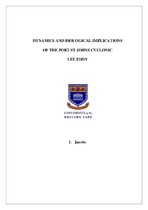| dc.description.abstract | This project describes the current dynamics of the cyclonic lee eddy off Rame
Head, Port St Johns and Waterfall Bluff, and how its physical forcing may
influence the biological communities. Three research surveys were conducted
during July 2013, December 2013 and July 2014 during which environmental data
(temperature, oxygen, salinity and chlorophyll) and biological samples
(zooplankton) were collected from 18 stations spanning latitudes 31.4 S - 32 S
and longitudes 29.3 E - 30 E.
A 300 kHz Acoustic Doppler Conductivity Profiler (ADCP) mooring deployed off
Port St Johns revealed maximum current velocities 1.5 m s-1, associated with
the Agulhas Current. Forty-one current reversals were observed over a 12 month
period, with most of these reversals noted on the bottom boundary layer. Warming
and cooling events were associated with these current reversals. Ship-ADCP
measurements also revealed inshore counter-currents and cyclonic flow along the
surface layers. There may have been a spin-up of a cyclonic eddy between Rame
Head and Port St Johns during July (2013 and 2014), which could have influenced
the productivity on the shelf during the winter months. Satellite altimetry also
revealed the presence of both cyclonic and anticyclonic eddies over and offshore of
the study area during the cruises. | |

